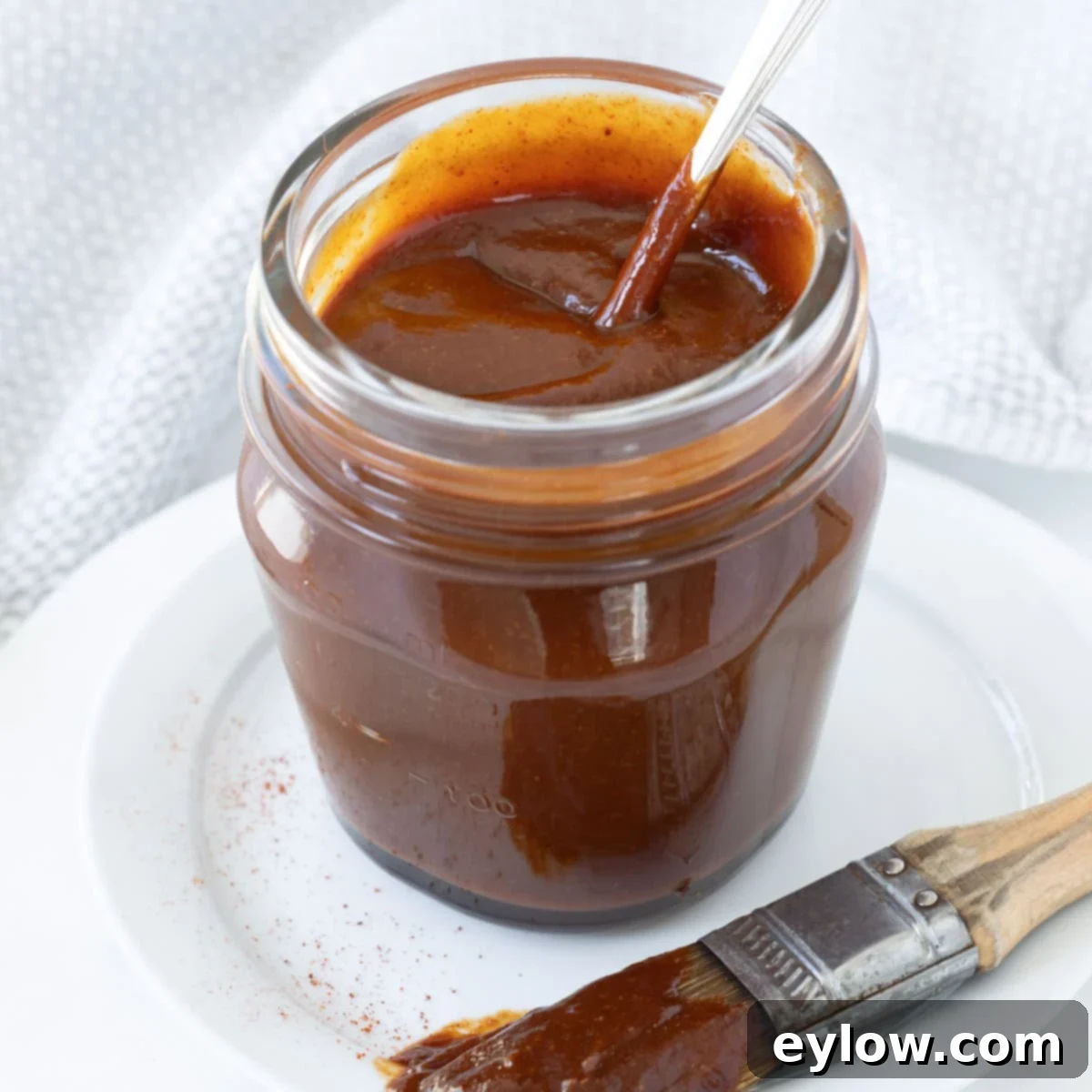Homemade Gluten-Free BBQ Sauce: Sweet, Tangy, and Perfectly Smoky for All Your Grilling Needs
Creating your very own gluten-free BBQ sauce from scratch is an absolute game-changer for anyone looking to elevate their grilling experience without the slightest worry of gluten contamination. This versatile sauce isn’t just for those with celiac disease or gluten sensitivity; it’s a universally loved condiment that truly works for everyone. Imagine slathering it generously on tender ribs, brushing it over succulent grilled chicken, or serving it as a delightful dipping sauce for barbecued shrimp. This homemade gluten-free BBQ sauce delivers a classic, robust flavor profile – a perfect harmony of smoky, tangy, and sweet notes that will have everyone reaching for more, completely unaware it’s gluten-free!
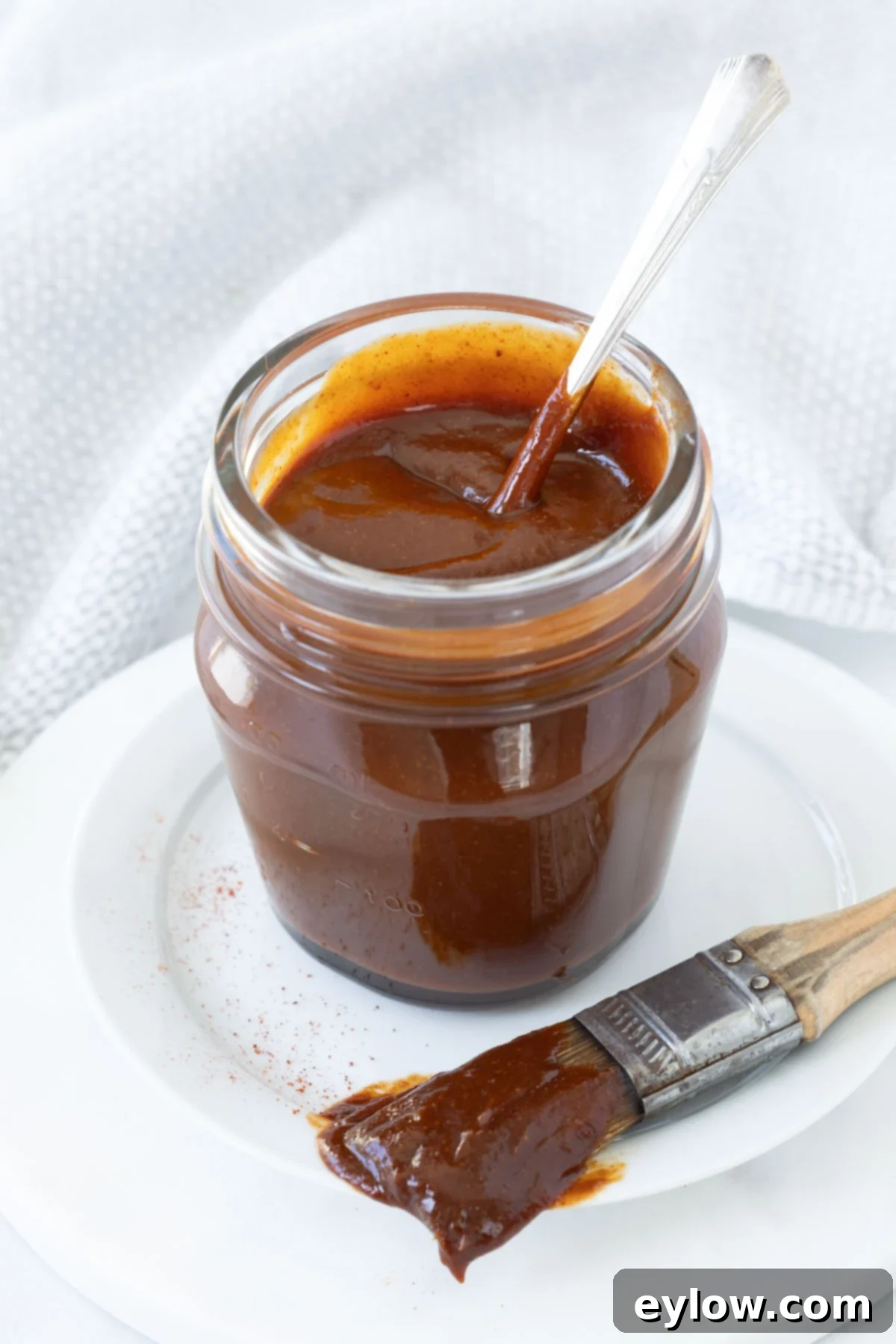
After countless hours of tinkering, testing, and tasting numerous batches, I’ve perfected this homemade gluten-free barbecue sauce recipe, and I’m thrilled to share it with you. Making your own BBQ sauce offers several significant advantages. Firstly, it allows you to completely avoid hidden gluten that can often be found in many commercial brands. Secondly, you gain full control over the ingredients, enabling you to customize the flavors to perfectly suit your individual taste preferences and specific dietary needs. This ensures a healthier, more delicious sauce every time.
Beyond catering to gluten-free requirements, crafting your own sauce means you can skip the unhealthy additives commonly found in popular store-bought barbecue sauces (yes, even some well-known brands like Sweet Baby Ray’s can be culprits). A quick glance at the package labels of many commercial sauces will reveal ingredients like high-fructose corn syrup, regular corn syrup, and various preservatives. By making it yourself, you ensure a cleaner, more natural product free from these undesirable elements, focusing solely on fresh, wholesome flavors.
[feast_advanced_jump_to]
Why You’ll Love This Homemade Gluten-Free BBQ Sauce Recipe
This homemade gluten-free BBQ sauce is designed for both ease and exceptional flavor, making it a favorite for many. Here’s why this recipe will quickly become a staple in your kitchen:
- Incredibly Quick to Prepare: You’ll be amazed at how little time it takes to whip up a batch of this delicious sauce. With just minutes of active preparation and cooking, you can have a fresh, flavorful BBQ sauce ready to go.
- Remarkably Versatile: This sauce isn’t a one-trick pony. It’s perfect for a wide array of grilling and cooking needs, whether you’re marinating, basting, dipping, or using it as a spread. Its balanced flavor profile complements almost any protein or vegetable.
- Uses Everyday Ingredients & Easy Customization: The recipe calls for common pantry staples, making it accessible for anyone to try. Furthermore, it’s incredibly forgiving and easily customizable. You can adjust the sweetness, heat, or tanginess to match your personal palate or any specific occasion.
- Healthier Choice: This recipe prioritizes health without sacrificing taste. It’s naturally gluten-free, with no added salt (beyond what’s in the ketchup and Worcestershire sauce), and offers lower sugar options. Plus, it can easily be adapted to be vegan by simply ensuring your Worcestershire sauce is anchovy-free.
- Beyond Gluten Sensitivity: While ideal for individuals with celiac disease or gluten sensitivity, this delicious BBQ sauce is perfect for anyone seeking a healthier, more flavorful condiment. It’s a clean-eating alternative that doesn’t compromise on the beloved smoky-sweet BBQ taste.
Essential Ingredients for Your Gluten-Free BBQ Sauce
Crafting the perfect gluten-free BBQ sauce relies on a careful selection of ingredients that bring together a symphony of sweet, smoky, and tangy notes. Here’s a detailed look at what you’ll need to create this fantastic homemade sauce:
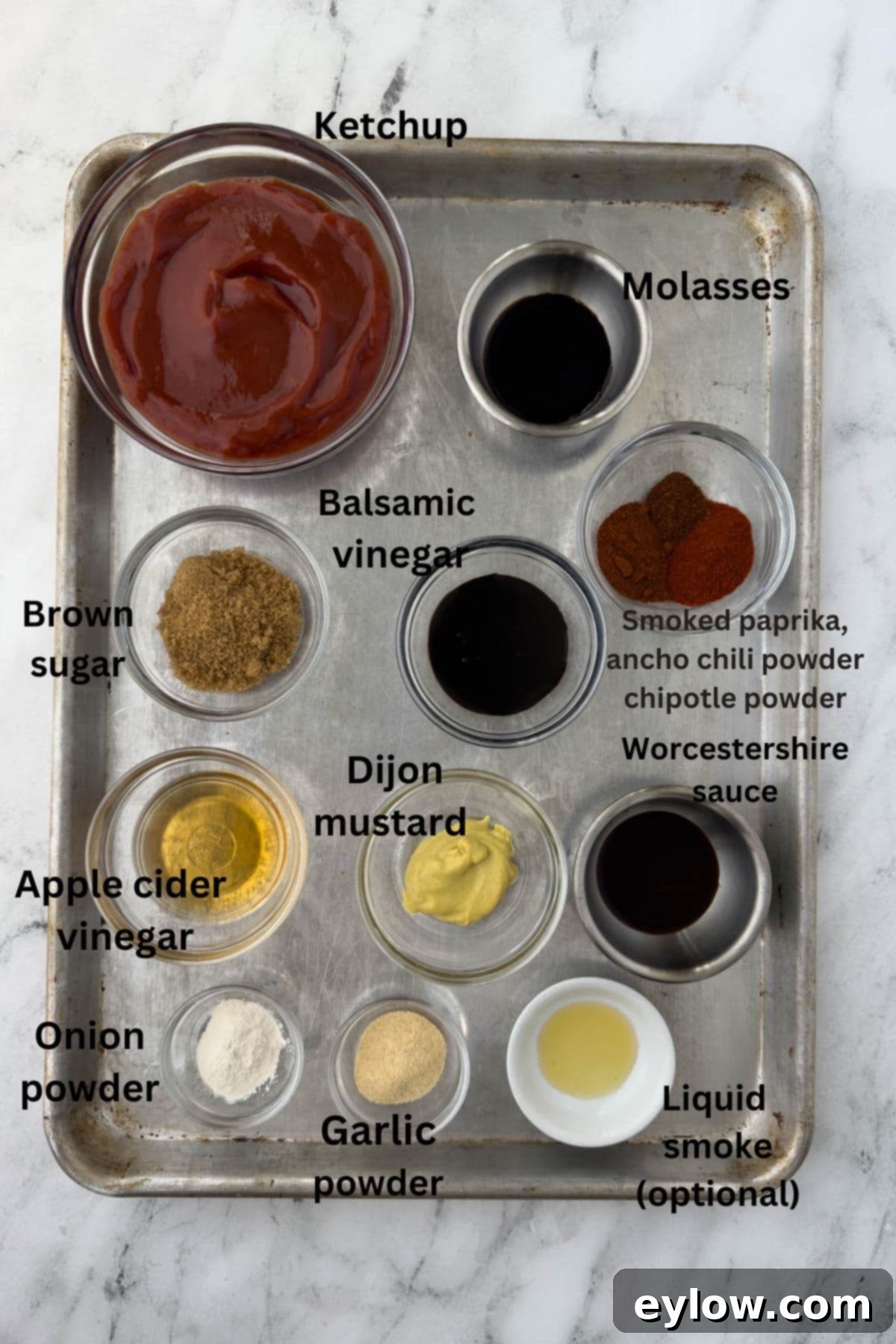
- Ketchup: This forms the foundational base of our BBQ sauce, providing a rich tomato flavor. I strongly recommend starting with a high-quality, unsweetened prepared tomato ketchup. This allows you to precisely control the overall sweetness of your final sauce. It’s a much simpler and quicker starting point than working with tomato paste. Here is the ketchup brand I prefer for its clean ingredient list.
- Sugar: For that essential sweetness and caramelization, you have several choices. Dark brown sugar will impart a deeper, richer molasses-like flavor, while light brown sugar offers a milder sweetness. Coconut sugar is another excellent option for a less refined sugar. For those seeking a no-sugar gluten-free BBQ sauce, golden brown monk fruit is a superb alternative that provides sweetness without the added sugar content.
- Molasses: This ingredient is key to achieving the signature deep, sweet, and rich flavor, as well as the beautiful dark color characteristic of traditional barbecue sauce. Don’t skip it if you want that authentic BBQ depth.
- Onion: While you could use chopped sweet onion or shallots, I find that onion powder is the easiest and most consistent option for this sauce. It blends seamlessly and provides a well-distributed onion flavor without any texture.
- Vinegar: We use a combination of vinegars for a balanced tang and complexity. Apple cider vinegar (or white vinegar, if preferred) delivers a sharp, bright tang that cuts through the sweetness. Balsamic vinegar adds a rich, sweet, and slightly fruity depth that elevates the overall flavor profile.
- Spices: A thoughtful blend of spices creates the classic BBQ aroma and taste. Cayenne pepper or chipotle pepper (which also adds a smoky note) provides a customizable kick of heat. Ancho chili powder contributes that distinctive smoky, earthy, and mildly spicy BBQ flavor. Finally, smoked paprika enhances the smokiness, and granulated garlic or garlic powder provides essential savory depth.
- Mustard: For a more complex flavor and a pleasant “kick,” I highly recommend using Dijon mustard. It offers a sharper, more sophisticated taste compared to plain mustard powder.
- Worcestershire Sauce: This ingredient is absolutely crucial for BBQ sauce. It lends a rich, savory, and deep umami flavor that ties all the other elements together beautifully. It’s a must-have for an authentic tasting sauce.
- Liquid Smoke: This is an optional but highly recommended liquid condiment that provides a natural smoke flavor without needing to smoke your sauce. It’s very concentrated, so use it sparingly – just a small amount makes a big impact!
Please refer to the detailed recipe card below for exact measurements of all ingredients.
Chef’s tip: Ensuring Gluten-Free Worcestershire Sauce. Is all Worcestershire sauce gluten-free? The answer is no; some brands contain gluten. It’s vital to check labels carefully. In the US, top brands like Lea & Perrins are certified gluten-free, as is The Wizard’s (which is also vegan, containing no anchovy). French’s Classic Worcestershire is another reliable gluten-free option. Always read the package label thoroughly for allergen notifications or look for a certified gluten-free seal. If you’re ever in doubt, don’t hesitate to call the company’s customer service number or research their website for product information.
Customizing Your Gluten-Free BBQ Sauce: Substitutions and Flavor Variations
One of the best aspects of making your own BBQ sauce is the ability to easily customize it to your exact preferences. Here are some fantastic ways to adjust this gluten-free recipe:
- For a Delicious Honey BBQ Sauce: If you love the sweet, floral notes of honey, you can easily transform this into a honey BBQ sauce. Simply swap out all or a portion of the brown sugar for an equal amount of honey. Using some of both can also create a wonderfully nuanced sweetness.
- For a Sweeter BBQ Sauce Without Added Sugar: For those managing sugar intake or preferring sugar-free options, monk fruit is your best friend. Instead of traditional sugar, use a brown or regular monk fruit blend. Ensure it’s a golden brown monk fruit if you want to maintain that deep caramel color and subtle flavor profile.
- For a Spicy BBQ Sauce with a Kick: If you prefer a sauce that brings the heat, there are several ways to amp up the spice. Add a dash or two of your favorite hot sauce, or increase the amount of cayenne pepper or chipotle pepper. Remember to add these carefully and taste as you go, as their potency can vary greatly. A little extra chipotle powder will also enhance the smoky undertones.
Chef’s tip: Soy Sauce in BBQ? Consider Tamari. Many traditional BBQ sauces incorporate soy sauce for its distinct salty and umami flavor. If you enjoy this addition, it’s crucial for a gluten-free recipe to use only tamari soy sauce. Tamari is a Japanese soy sauce that is typically made without wheat, making it a safe, gluten-free alternative to regular soy sauce, which almost always contains wheat. I’ve intentionally left soy sauce out of this particular recipe to cater to those who are soy-sensitive, as soy is a common allergen. However, if you’re not soy-sensitive and appreciate that extra layer of savory depth, feel free to add a little. Start with a teaspoon or two, then taste and adjust. Even low-sodium tamari brands can be quite high in sodium, so add judiciously.
Simple Steps to Homemade Gluten-Free BBQ Sauce
Making homemade BBQ sauce is incredibly straightforward and rewarding. Why bother with store-bought when you can have fresh, flavorful sauce ready in minutes? Say goodbye to expired bottles cluttering your fridge – this recipe takes about 5 minutes of active cooking time!
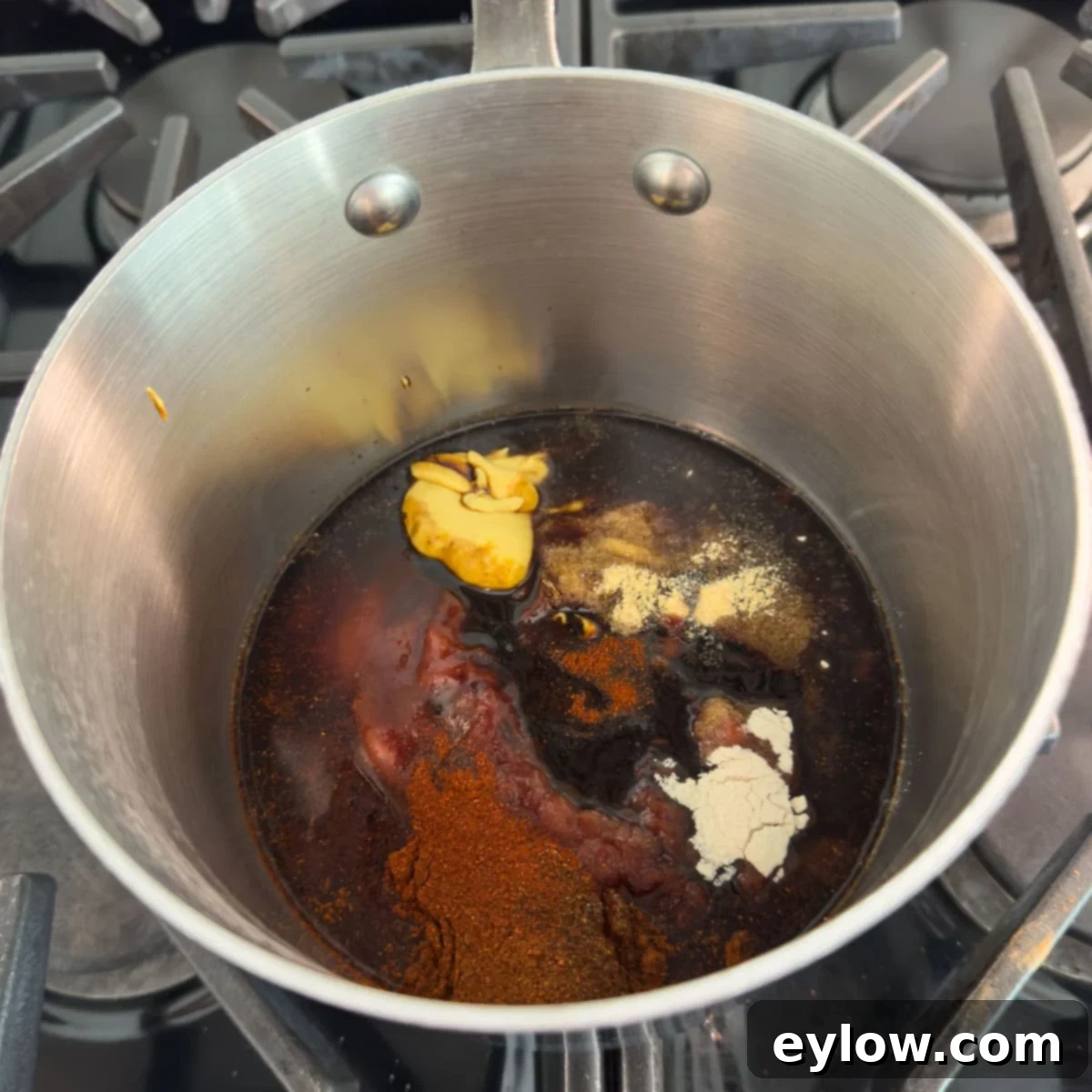
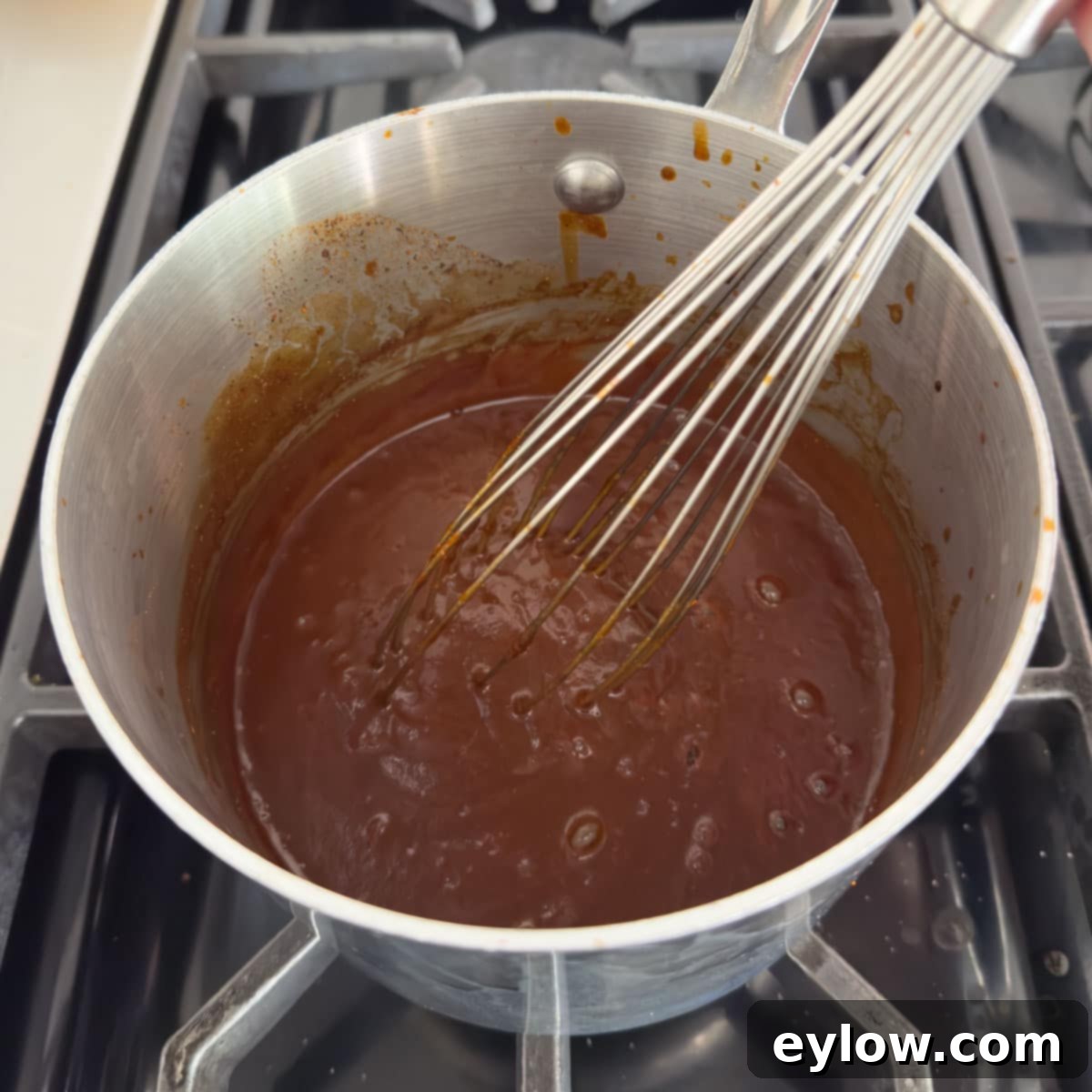
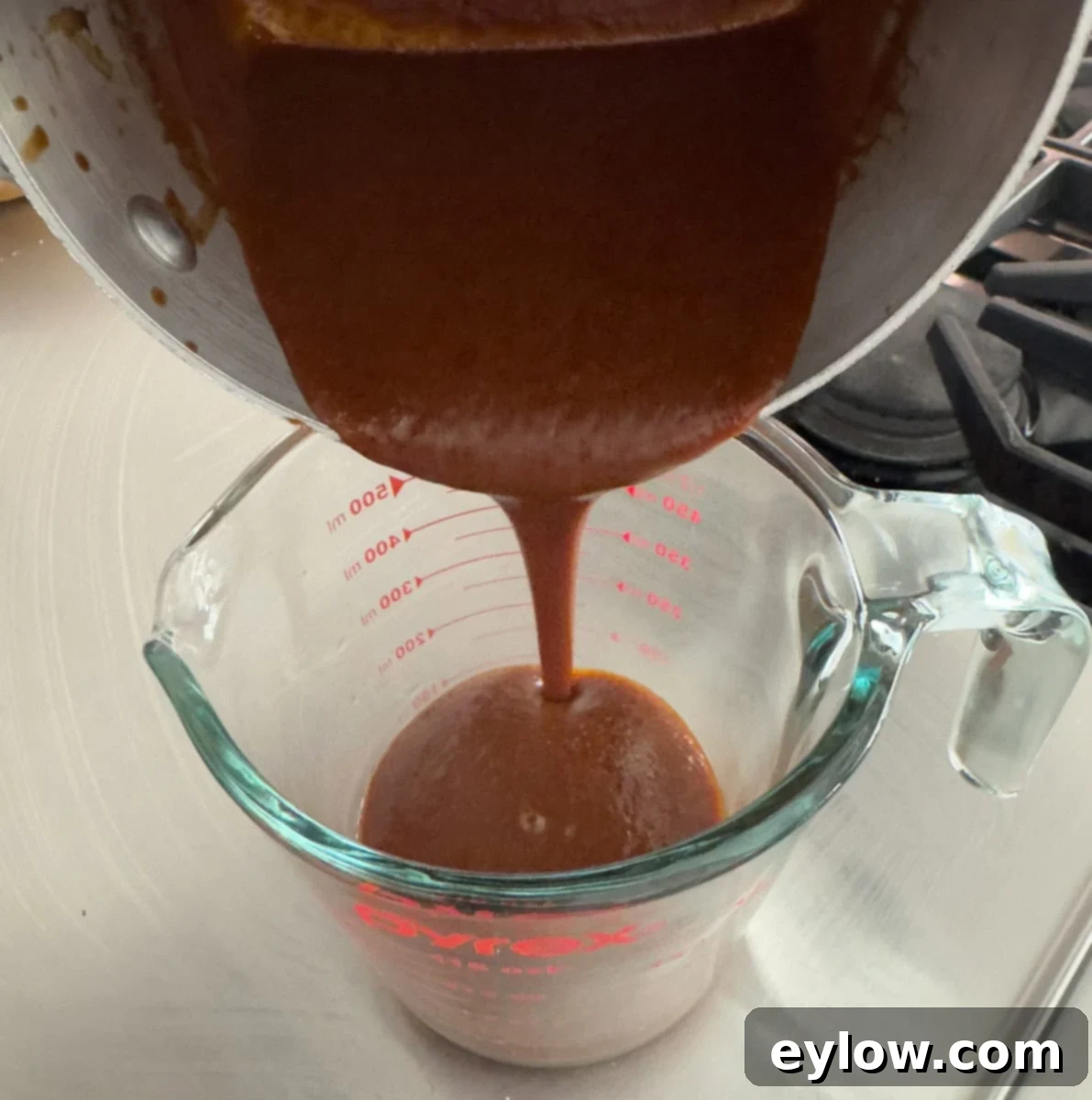
Step 1: Gather and Combine. Start by gathering all your ingredients. In a small (2-quart) saucepan, combine the unsweetened ketchup, water, brown sugar (or monk fruit), apple cider vinegar, molasses, balsamic vinegar, Worcestershire sauce, Dijon mustard, smoked paprika, ancho chili powder, garlic powder, onion powder, cayenne pepper (or chipotle pepper), and liquid smoke (if using). Ensure your saucepan is appropriately sized to prevent splatters as the sauce simmers.
Step 2: Whisk and Simmer. Place the saucepan over medium heat. Using a whisk, stir all the ingredients together until they are thoroughly combined and smooth. Continue whisking gently as the sauce comes to a simmer. Once it starts bubbling, reduce the heat slightly if needed to maintain a gentle simmer. Allow the sauce to cook for about 3-4 minutes, continuing to whisk occasionally. During this time, the flavors will meld, and the sauce will begin to thicken to a beautiful, glossy consistency. The goal is a rich, smooth sauce, so ensure there are no lumps.
Step 3: Cool and Store. Once your BBQ sauce has reached the desired consistency, remove the pan from the heat. Carefully pour the hot barbecue sauce into a clean, heat-proof container. Allow the sauce to cool completely at room temperature before covering it. Once fully cooled, transfer the sauce to an airtight container and refrigerate. For optimal freshness and safety, remember to label and date your container. This homemade gluten-free BBQ sauce will keep beautifully in the refrigerator for up to two weeks, ready for your next grilling adventure!
Delicious Ways to Enjoy Your Homemade Gluten-Free BBQ Sauce
This homemade gluten-free BBQ sauce is incredibly versatile and can be used in countless ways to add a burst of smoky, tangy, and sweet flavor to your meals. Don’t limit yourself to traditional uses – get creative!
- Dipping Sauce Extraordinaire: It’s the ultimate dipping companion for crispy sweet potato fries or potato wedges. Its robust flavor stands up perfectly to these savory sides.
- Grilled Shrimp Perfection: Brush it onto grilled shrimp immediately after they come off the grill. The heat will caramelize the sauce slightly, creating a mouthwatering glaze.
- A Hoisin Sauce Alternative: For an American BBQ twist, use this sauce instead of hoisin sauce for these grilled chicken kabobs. It provides a familiar yet exciting flavor profile.
- Elevate Your Burger: Forget plain old ketchup! Smear a generous amount of this BBQ sauce over your burger patties for an instant upgrade in flavor. It’s also fantastic on vegetarian burgers.
- Ribs’ Best Friend: A rich, thick layer of this sauce is absolutely a must for fall-off-the-bone baby back ribs, whether you’re cooking them in the oven or on the grill.
- Salmon’s Secret Weapon: Terrific as a glaze for grilled, broiled, baked, or stovetop seared salmon. The sweet and smoky notes pair beautifully with the richness of the fish.
- Grilled Vegetable Enhancer: Lightly brush it over grilled corn on the cob, zucchini, or bell peppers for an added layer of flavor and a beautiful glaze.
- Sandwich and Wrap Spread: Use it as a flavorful spread in sandwiches, wraps, or even as a base for pulled pork or chicken sliders.
- Pizza Base: For a unique twist on pizza night, use this BBQ sauce as the base instead of tomato sauce, then top with chicken, red onion, and cheese.
- Ultimately, use it almost anywhere you’d typically use ketchup for a more dynamic and flavorful experience.
Gluten-Free BBQ Sauce: Your Questions Answered
When making homemade BBQ sauce or checking store-bought options, it’s essential to be aware of common gluten-containing culprits. The primary ingredient to watch out for is Worcestershire sauce; many traditional brands contain barley malt vinegar or other wheat-derived ingredients. Fortunately, several excellent gluten-free Worcestershire sauces are available, such as Lea & Perrins (in the US), The Wizard’s (which is also vegan), and French’s Classic Worcestershire. Another common hidden source of gluten is soy sauce, which is typically made with wheat. If you want to include a soy-like flavor, always opt for tamari, a wheat-free alternative. Other ingredients to scrutinize include barley malt, malt vinegar, and modified food starch, which may be derived from wheat. Always read package labels very carefully. If you’re ever in doubt about an ingredient, the safest approach is to contact the company’s customer service line directly or check their official website for allergen information and certified gluten-free statements.
Generally, the best and simplest way to thicken this homemade BBQ sauce is by simmering it gently over medium-low heat in a small pan. As the sauce cooks down, the water content evaporates, leaving a naturally thicker consistency. If you find your sauce still needs additional thickening, or if you prefer a very thick glaze, arrowroot starch is an excellent gluten-free thickening agent. It’s preferred by many because it provides a clear, glossy finish without altering the flavor. To use arrowroot, first create a slurry: mix one tablespoon of arrowroot starch with one to two tablespoons of cold water until it forms a smooth paste. Then, gradually whisk this slurry into your bubbling BBQ sauce. Continue to stir gently for about 1-2 minutes until the sauce visibly thickens. Once thickened, remove from heat, cool, and refrigerate. Avoid over-cooking after adding arrowroot, as prolonged high heat can sometimes cause it to break down and lose its thickening power.
To maintain the freshness and quality of your homemade gluten-free BBQ sauce, proper storage is key. Once the sauce has completely cooled to room temperature, transfer it into a clean, airtight container. Mason jars or other glass containers with tight-fitting lids work wonderfully. Make sure to label the container with the date it was made. Store the sauce in the refrigerator for up to two weeks. Always trust your senses: if the sauce smells “off,” develops any mold, or looks unusual, it’s best to err on the side of caution and discard it. Thankfully, since it’s so quick and easy to make, whipping up a fresh batch is always a good option. While BBQ sauce can be frozen for longer storage (up to 3 months in freezer-safe containers), the texture can sometimes change slightly upon thawing. Given how little time it takes to prepare, many prefer to make smaller, fresh batches as needed for the best taste and consistency.
More Delicious Recipes to Complement Your Grilling!
Now that you have your incredible homemade gluten-free BBQ sauce, you’ll need some fantastic dishes and sides to go with it! Explore these complementary recipes:
- Homemade BBQ Spice Rub
- Baby Back Ribs Recipe (Oven Method)
- Simple Easy Coleslaw Recipe
- Crunchy Broccoli Salad with Bacon
⭐️ Did You Make This Recipe? We’d Love to Hear From You!
If you give this homemade gluten-free BBQ sauce recipe a try, please take a moment to add your comment below. Your feedback is incredibly valuable, and I truly enjoy hearing about your cooking experiences. If you loved it as much as I do, please consider giving it a 5-star rating! Your ratings and reviews greatly help other readers discover and enjoy this delicious recipe.
📖 Recipe
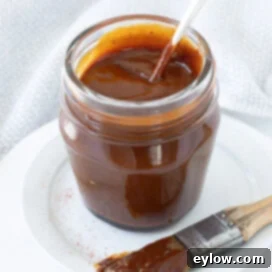
Gluten-Free BBQ Sauce
Sally Cameron
Pin Recipe
Equipment
-
Small pan like a 2 quart
Ingredients
- 1 cup unsweetened ketchup
- ¼ cup water
- 2 tablespoons brown sugar or golden monk fruit
- 1 tablespoons apple cider vinegar or white vinegar
- 1 tablespoon molasses
- 1 tablespoon balsamic vinegar
- 2 teaspoons worcestershire sauce
- 2 teaspoons dijon mustard
- 1 teaspoon smoked paprika
- 1 teaspoon ancho chili powder
- 1 teaspoon garlic powder
- ¼ teaspoon onion powder
- ¼ teaspoon cayenne pepper or chipotle pepper
- ⅛ teaspoon liquid smoke optional
Instructions
-
Combine all ingredients in a small (2-quart) saucepan. Whisk until smooth over medium heat until the mixture begins to bubble. Continue to cook for 3-4 minutes, whisking occasionally, until the sauce is smooth and has thickened to your desired consistency. If it’s cooking too fast, turn the heat down slightly. Remove the pan from the heat and allow the sauce to cool completely at room temperature. Once cooled, transfer the sauce to an airtight container, label, and date it. It can be refrigerated for up to two weeks.
Notes
- For a sweeter BBQ sauce, you can easily add more brown sugar, use an alternative like golden monk fruit, or incorporate a touch of honey for a different type of sweetness. Adjust gradually to taste.
- If you prefer a hotter and spicier BBQ sauce, feel free to increase the amount of cayenne pepper or chipotle powder. For a deeper, more complex heat, consider adding a dash of your favorite hot sauce. Remember to add carefully and taste test as you go, as spice levels can quickly escalate!
- To achieve a tangier flavor profile, simply add a little more apple cider vinegar or even a splash of lemon juice. This brightness can balance out the sweetness and richness.
- This recipe yields a wonderfully thick BBQ sauce, perfect for slathering. If you prefer a thinner consistency, perhaps for a lighter glaze or marinade, you can easily thin it down by whisking in a small amount of water (about a tablespoon at a time) until it reaches your desired texture.
I developed this recipe using Primal Kitchen brand organic unsweetened ketchup. The nutritional analysis per serving provided below reflects the use of this specific ketchup. Different brands may slightly alter the nutritional values.
